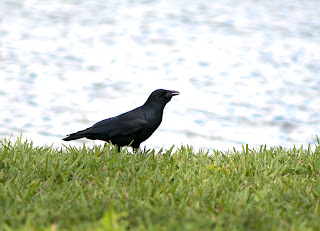The greater Miami area holds a good number of Florida specialty birds, some of which I missed during my time down there a few weeks back. Plus, a Thick-billed Vireo is being reported from Bill Baggs State Park. This was all the persuasion I needed to devise a crazy whirlwind Miami weekend. A little over 7 hours and 500 miles from Tall Timbers, we would have to cram if we wanted to see everything in only a typical weekend and be back in time for work on Monday.
So, after work on Friday I went straight to bed, slept for 5-6 hours and left Tallahassee with Matt Gould at 11:45pm Friday night. Two and half hours later we picked Craig Bateman up in Gainesville and continued south. We met with Alex Harper in Miami shortly after sunrise. Since Bill Baggs didn't open until 8am, we decided to try for Spot-breasted Oriole in Miami Shores. Eventually, we found them and I got my best looks ever at this beautiful exotic.
 |
| Spot-breasted Oriole |
We jolted to Bill Baggs, hoping to catch a glimpse of the reported Thick-billed Vireo, a would-be new ABA bird for me. Upon arrival, a group of birders were staring intently past the white gate. The vireo was audible, but not visible. The bird became silent. This would be the case for the remainder of the time we spent at this location. There were a few other migrants around including multiple Northern Parula and Ovenbirds.
We then drove down to Homestead to a private residence hosting a huge cowbird flock including multiple Shiny Cowbirds. We got fleeting glimpses of them as they passed into the bushes surrounding the feeders and had to wait them out until they began feeding on the ground. Once they did, the Cowbirds really glowed in the high sun.
 |
| Shiny Cowbird |
We were doing well on time, so we went to Kendall to look for those elusive Red-whiskered Bulbul. Alex noted that they are tough to find after 10am when they become mostly silent. Some luck was going to be involved in the finding of these birds. After checking across from the Baptist Hospital and Kendallwood and coming up empty, we tried the tennis courts. While we didn't find any Bulbul, this Broad-winged Hawk was a fun bird to see.
 |
| Broad-winged Hawk |
We went back to the Kendallwood neighborhood. Alex heard a Bulbul give a quick call, so we parked and I quickly got on a Bulbul sitting on a wire in a backyard. We followed what turned out to be a pair as they moved down the wires. They weren't close, but this picture will do.
 |
| Red-whiskered Bulbul |
We also saw Nanday, White-winged and Monk Parakeets in Miami. I want to thank Alex Harper for this help with finding all of these Miami specialties. His intimate knowledge of seemingly every individual bird in Miami made seeing all these birds in a relatively short time possible. He guides people around Miami and if you are serious about seeing all the specialties, I would seriously consider hiring him. You wont regret it: (alexkharper@gmail.com)
Sunday morning we woke before sunrise and gave a few screech owl calls. We were greeted with an Eastern Screech-Owl that landed on the power wires and called a few times. No other screech owl range comes even remotely close to Florida.
 |
| Eastern Screech-Owl |
Back to Bill Baggs, we gave the Thick-billed Vireo another shot. We heard it scold close to the gate, and we all saw a flash of movement coming from the same area. Unfortunately, the bird moved further back. We were on a tight schedule as it was, so we moved to Green Cay. Later we would discover the Vireo was seen both Saturday and Sunday later in the afternoon. Fail.
The La Sagra's Flycatcher at Green Cay wasn't any more visible than the vireo. We heard it call a few times, but the bird never revealed itself. The boardwalk was more productive. Least Bitterns are nesting along the far edge of the wetlands.
 |
| Least Bittern |
Back near the parking lot, the Yellow-breasted Chat was being enjoyed by a few observant birders.
 |
| Yellow-breasted Chat |
At Wakodahatchee, the Neotropic Cormorant was difficult to pick out as it is quite ragged and worn. However, the small bill, small size, v-shaped chin-patch border, and faint white border to the chin-patch gave it away.
 |
| Neotropic Cormorant |
It was a long drive home. Was quite tired for work today, but not too tired to pass off this singing Yellow-throated Vireo. Quite a few returning breeders around and singing, especially Northern Parulas.
 |
| Yellow-throated Vireo |
Hopefully some more migrants show up this week. As for this coming weekend, I think I need to chase that White-cheeked Pintail. Then the Vireo is only a couple more hours south...
Also, a huge thank you to all of those who have made pledges for this big year. It really keeps me motivated and is going for a great cause! If you haven't already, check out this page for more info :
Donate

































